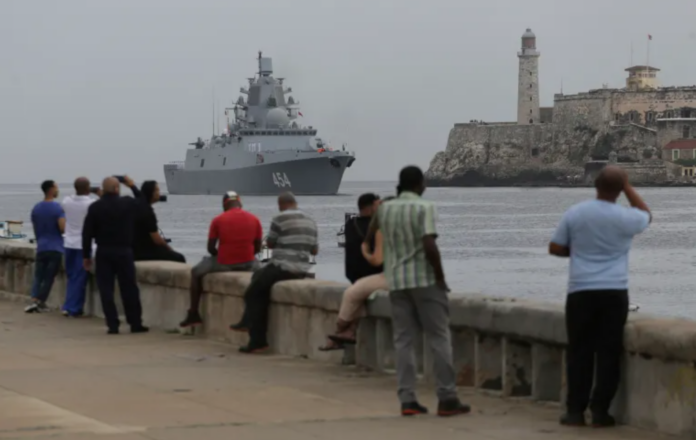HAVANA: A Russian navy frigate and a nuclear-powered submarine arrived in Havana harbor, a visit that both the US and Cuba stated posed no threat, though it is widely viewed as a show of force by Russia amidst rising tensions over the Ukraine war.
Curious onlookers, fishermen, and police lined the Malecon seafront boulevard under grey skies to welcome the ships as they passed the 400-year-old Morro castle at the harbor’s entrance.
Cuba, a long-time ally of Russia, saluted the ships’ arrival with cannon fire from the harbor. Russian diplomats waved small Russian flags and took selfies as the vessels passed the harbor’s historic fortresses.
The Admiral Gorshkov frigate, and later the nuclear-powered submarine Kazan, half-submerged with its crew on deck, were accompanied by a tugboat and fuel ship that had arrived earlier in the morning.
The four Russian vessels sailed to Cuba on Wednesday after conducting “high-precision missile weapons” training in the Atlantic Ocean, according to Russia’s defense ministry.
The submarine and frigate are armed with Zircon hypersonic missiles, Kalibr cruise missiles, and Onyx anti-ship missiles, the ministry said.
Cuba stated last week that the visit was standard practice for naval vessels from countries friendly to Havana. The communist-run government’s foreign ministry confirmed that the fleet carried no nuclear weapons, a claim echoed by US officials.
The US has been monitoring the Russian vessels as they skirted the nearby Florida coast but has stated they pose no threat. White House national security adviser Jake Sullivan told reporters on Wednesday that such naval exercises were routine.
“We have seen this kind of thing before and we expect to see this kind of thing again, and I’m not going to read into it any particular motives,” Sullivan said. He added that there was no evidence of Russia transferring any missiles to Cuba, but the US would remain vigilant. “We do not expect anything like that to occur.”
Havana is just 100 miles from Key West, Florida, home to a US Naval Air Station. The timing of the visit—as the Biden administration considers its stance on defending Ukraine against Russia—suggests more than “standard practice,” said William Leogrande, a professor at American University.
“The visiting Russian warships are Putin’s way of reminding Biden that Moscow can challenge Washington in its own sphere of influence,” Leogrande said.
The stopover coincides with Cuba’s worst social and economic crisis in decades, marked by shortages of food, medicine, and fuel, and growing discontent on the streets. “This […] has echoes of the Cold War, but unlike the first Cold War, the Cubans are drawn to Moscow not by ideological affinity but by economic necessity,” Leogrande said.






















